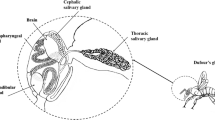Abstract
The Himalyan honeybee, Apis laboriosa, is sometimes considered to be a form of the rock honeybee, A. dorsata, rather than a separate species. Analyses of potential exocrine compounds produced by both forms revealed that the cephalic and abdominal natural products of these two honeybees shared no common denominators. The sting shaft of workers of A. dorsata is the source of a large series of esters dominated by 1-acetoxy-2-decene. Other major constituents include isopentyl acetate, accompanied by isopentyl propionate, farnesyl acetate, and several other esters. On the other hand, nothing but presumed structural lipids (e.g., ethyl palmitoleate) were identified from sting shafts of workers of A. laboriosa. By contrast, cephalic (including mandibular glands) extracts from workers of A. laboriosa contained γ-octanoic lactone, whereas comparable extracts of A. dorsata workers contained only structural lipids. The major qualitative differences in the chemical characters between A. laboriosa and A. dorsata are consistent with the designation of these two forms as distinct species.
Similar content being viewed by others
REFERENCES
Alexander, B. 1990. A phylogenetic analysis of honey bees (Hymenoptera: Apidae: Apis), pp. 120–121, in G. K. Veersh, B. Malik, and C. A. Viraktamath (eds.). 11th International Congress—IUSSI 1990, Bangalore, India. Oxford & IBH Publ., New Delhi, India.
Blum, M. S., and Fales, H. M. 1988. Chemical releasers of alarm behavior in the honey bee: Informational plethora of the sting apparatus signal, pp. 141–148, in G. R. Needham, R. E. Page, M. Delfinado-Baker, and C. E. Bowman (eds.). Africanized Honey Bees and Bee Mites. Halsted Press, New York.
Boch, R., Shearer, D. A., and Stone, B. C. 1962. Identification of isoamyl acetate as an active component in the sting pheromone of the honeybee. Nature 195:1018–1020.
Collins, A., and Blum, M. S. 1982. Bioassay of compounds derived from the honey bee sting. J. Chem. Ecol. 8:463–470.
Dietz, A. 1992. Honey bees of the world, pp. 23–71, in J. Graham (ed.). The Hive and the Honey Bee. Dadant and Son, Hamilton, Illinois.
Koeniger, N. 1990. Coevolution of Asian honey bees and their mites, pp. 130–131, in G. K. Vereesh, B. Malik, and C. A. Viraktamath (eds.). 11th International Congress—IUSSI 1990, Bangalore, India. Oxford & IBH Publ., New Delhi, India.
Koeniger, N., Weiss, J., and Maschwitz, U. 1979. Alarm pheromones of the sting in the genus Apis. J. Insect Physiol. 25:467–476.
Mcevoy, M. V., and Underwood, B. A. 1988. The drone and species status of the Himalyan honey bee, Apis laboriosa (Hymenoptera: Apidae). J. Kans. Entomol. Soc. 61:246–249.
Roubik, D. W. 1990. Nesting defense in tropical honey bees and stingless bees: you are what you eat, pp. 662–665, in G. K. Vereesh, B. Malik, and C. A. Viraktamath (eds.). 11th International Congress—IUSSI, Bangalore, India. Oxford & IBH Publ., New Delhi, India.
Roubik, D. W., Sakagami, S. F., and Kudo, I. 1985. A. laboriosa is ecologically distinct from A. dorsata. J. Kans. Entomol. Soc. 61:246–249.
Ruttner, F. 1988. Biogeography and Taxonomy of Honeybees. Springer-Verlag, Berlin.
Sakagami, S. F., Matsumura, and Ito, K. 1980. Apis laboriosa in Himalaya, the little known world's largest honey bee (Hymenoptera, Apidae). Insect Matsumurana 19:276–290.
Shearer, D. A., and Boch, R. 1965. 2-Heptanone in the mandibular gland secretion of the honeybee. Nature 206:530.
Underwood, B. A. 1990. Time of drone flight of Apis laboriosa Smith in Nepal. Apidologie 21:501–504.
Author information
Authors and Affiliations
Rights and permissions
About this article
Cite this article
Blum, M.S., Fales, H.M., Morse, R.A. et al. Chemical Characters of Two Related Species of Giant Honeybees (Apis dorsata and A. laboriosa): Possible Ecological Significance. J Chem Ecol 26, 801–807 (2000). https://doi.org/10.1023/A:1005476405192
Issue Date:
DOI: https://doi.org/10.1023/A:1005476405192




